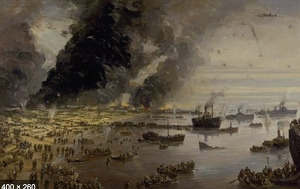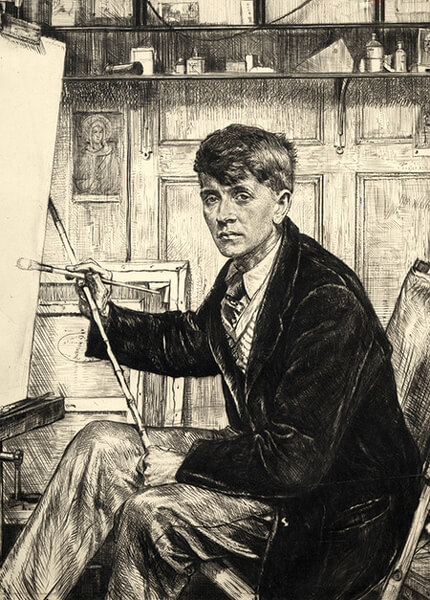
The station silhouetted in the background has the arched roof and corner turrets of Cannon Street (the roof was blown off in the war) but that doesn’t fit with anything else in the picture, including what looks like an LNER express locomotive in the freight yard. According to the artist’s daughter this scene would have been based on fact and his memory of such scenes: Cundall really respected reality, and didn’t try and overload it with personal interpretation.
The present work illustrates both the destruction and human spirit that prevailed in London (and the U.K.) during The Blitz, 1940-1941. Painted in 1941, the viewer is presented with a train yard and hive of industry as men scurry and stoop to mend damaged tracks and get the engines going. All around them light and fires rage from the Luftwaffe air raid explosions and searchlight beams highlight a sombre sky filled with deterrent barrage balloons. They work under the darkness of night, focussing on the task in hand with the ‘carry on’ of the title recalling the motivational poster produced just a couple of years prior during WWII that advised the public to ‘Keep Calm and Carry on’. Reinforcing the message, in late May and early June 1941, 14,000,000 copies of a leaflet entitled ‘Beating the Invader’ were distributed with a message from Prime Minister Winston Churchill. The leaflet begins “If invasion comes…” and exhorts the populace to “Stand Firm” and “Carry On”. Exhibited at The Royal Academy in the year of its execution, The British Railway’s Carry On may be viewed as a pictorial representation of that Great British sensibility, to maintain a ‘stiff upper lip’ in the face of adversity.
At the start of World War II, Cundall worked for the War Artists’ Advisory Committee and latterly as an Admiralty artist working on Merchant Navy subjects. As such, he spent time on the Medway, in the West Country and also on the Thames with the latter surely influencing the present work which brings to mind the area of Blackfriars in London. The artist produced other works in this vein and on an epic scale including his seminal The Withdrawal from Dunkirk (1940) now in the collection of The Imperial War Museum, London.

We are grateful to Jackie Setter and Ian Jack for assistance

Painter, potter and stained glass artist, born in Stratford, Lancashire. After working as a designer for Pilkington’s Pottery Company under Gordon Forsyth, Cundall studied at Manchester School of Art, obtaining a scholarship to the Royal College of Art, 1912. After World War I army service he returned to the Royal College in 1918, then from 1919 to 1920 attended the Slade, and furthered his studies in Paris. Cundall traveled widely in several continents and became noted for his panoramic pictures, such as Bank Holiday Brighton, in the Tate Gallery (accession no. NO4700). He was a member of NEAC, RP, RWS and other bodies and was a prolific RA exhibitor. He had first solo show at Colnaghi 1927. He was an Official War Artist in World War II, during which time he was sent to Quebec (1944). In the same year he was elected RA. His wife was the artist Jacqueline Pietersen.
His technical facility – especially when working on large panoramic canvases – was remarkable. His pictures are rich with texture, light and movement. He was equally at ease with aerial views, landscapes, seascapes and cityscapes, and was a master of crowd scenes. His work as an Official War Artist has never received the attention it merits.